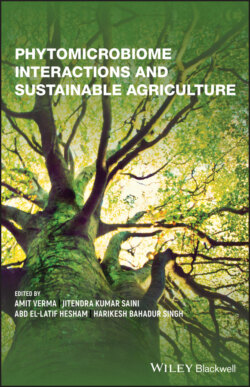Читать книгу Phytomicrobiome Interactions and Sustainable Agriculture - Группа авторов - Страница 2
Table of Contents
Оглавление1 Cover
2 Title Page
3 Copyright Page
4 Dedication Page
5 List of Contributors
6 Preface
7 About the Editors
8 1 Plant Root Exudate Analysis 1.1 Introduction 1.2 Root Exudates Composition: Collection and Analysis 1.3 Role of Root Exudates in Shaping Rhizospheric Microbiomes 1.4 Applications of Root Exudation 1.5 Conclusion and Future Prospects References
9 2 Phytoproteomics 2.1 Introduction 2.2 Phytomicrobiome 2.3 Phytomicrobiome: The Communication via Signaling 2.4 Proteomics 2.5 Analysis of Phytomicrobial Interactions Using Proteomics Approaches 2.6 Conclusion and Future Prospects References
10 3 Metagenomics 3.1 Introduction 3.2 Metagenomics 3.3 Metagenomics of Plant Rhizosphere 3.4 Metagenomics of Plant Phyllosphere 3.5 Metagenomics of Plant Endosphere 3.6 In‐silico Tools for Metagenome Analysis 3.7 Recent Progress in Metagenomic Studies of Plant Microbiome 3.8 Conclusion and Future Prospects References
11 4 Combating the Abiotic Stress Through Phytomicrobiome Studies 4.1 Introduction 4.2 Phytomicrobiome Signaling Compounds 4.3 Mechanisms of Phytomicrobiome Associated with Abiotic Stress Tolerance 4.4 Importance of Phytomicrobiome Engineering for Crop Stress Alleviation 4.5 Omics Strategies in Phytomicrobiome Studies 4.6 Conclusion and Future Prospects Acknowledgments References
12 5 Microbial Diversity of Phyllosphere 5.1 Introduction 5.2 Origin of Phyllosphere Microflora 5.3 Tools to Study Phyllomicrobiome 5.4 Biodiversity of Phyllosphere 5.5 Microbial Adaptation to Phyllosphere 5.6 Interaction of Phyllomicrobiota with Plants 5.7 Significance of Phyllomicrobiome Studies 5.8 Conclusion and Future Prospects References
13 6 Rhizosphere Engineering 6.1 Introduction 6.2 Natural Plant–Microbe Interactions in Rhizosphere 6.3 Molecular Mechanisms in Plant–Microbe Interactions in Rhizosphere 6.4 Biochemical Components in Rhizosphere Signaling 6.5 Tools and Techniques in Rhizosphere Engineering 6.6 Rhizosphere Components Amenable to Engineering 6.7 Conclusion and Future Prospects Acknowledgment References
14 7 Plant Communication with Associated 7.1 Introduction 7.2 Biofilm and Rhizospheric Interactions 7.3 Biofilm Formation at the Root Rhizosphere 7.4 Genetic Features Responsible for Bacterial Cell Adhesion to Plant System 7.5 Nutrient Interactions 7.6 Biotic Interaction 7.7 Conclusion and Future Prospects References
15 8 Phytomicrobiome 8.1 Introduction 8.2 Phytoremediation 8.3 Phytomicrobe Interactions and Rhizomediation 8.4 Conclusion and Future Prospects References
16 9 Rhizospheric Biology 9.1 Introduction 9.2 Engineering the Rhizosphere 9.3 Engineering Soil Microbial Populations and Plant–Microbe Interactions 9.4 Plant Growth‐Promoting Rhizobacteria: Mechanisms, Potential, and Usages 9.5 Plant–Microbe Interaction 9.6 Biofertilizers and its Applications 9.7 Plant Genetic Engineering 9.8 Conclusion and Future Prospects Acknowledgments References
17 10 Application of Inorganic Amendments to Improve Soil Fertility 10.1 Introduction 10.2 Impact of Bhoochetna Movement in Southern India 10.3 Sustainable Agriculture 10.4 Factors to Be Considered While Selecting a Soil Amendment 10.5 Advantages of Soil Amendments 10.6 Land Modeling 10.7 Major Applications of Soil Amendments 10.8 Combination Strategy for Soil Quality Improvement 10.9 Conclusion and Future Prospects References
18 11 Improved Plant Resistance by Phytomicrobiome Community Towards Biotic and Abiotic Stresses 11.1 Introduction 11.2 Microbes and Plants 11.3 Response of Abiotic Response on Plant 11.4 Role of Phytohormones in Increasing Abiotic and Biotic Stress Tolerance 11.5 Gene Transfer in Plants 11.6 Conclusion and Future Prospects References
19 12 Bioprospecting 12.1 Introduction 12.2 Plant‐Associated Microbial Communities 12.3 Beneficial Effects of Plant‐Associated Microbial Communities 12.4 Role of Microbial Processing (Signals) in Facilitating Plant Growth 12.5 Conclusion and Future Prospects Acknowledgments References
20 13 Advances in Omics and Bioinformatics Tools for Phyllosphere Studies 13.1 Introduction 13.2 Recent Trends and Approaches 13.3 Computing for Biology 13.4 Bioinformatics in Microbial Research 13.5 Phyllosphere Microbiome Studies Based on Genome‐Wide Association 13.6 Omics Strategies and Their Integration 13.7 Conclusion and Future Prospects References
21 14 Microbial Mediated Zinc Solubilization in Legumes for Sustainable Agriculture 14.1 Introduction 14.2 Chronological Events of Zinc Biology 14.3 Role of Zinc in Living System 14.4 Zinc Deficiency vs. Zinc Toxicity in Crop Plants 14.5 Availability of Zinc in Soil Environment 14.6 Factors Affecting Zinc Availability to Plants 14.7 Response of Legume Crops to Zinc 14.8 Microbial Mediated Zinc Solubilization in Legume Crops 14.9 Conclusion and Future Prospects References
22 15 Composition and Interconnections in Phyllomicrobiome 15.1 Introduction 15.2 Significance of Phyllospheremicrobiota 15.3 Phyllosphere Microorganisms as Plant Growth Regulator 15.4 Plant–Pathogen Interactions Mediated by Phyllosphere Microbiome 15.5 Conclusion and Future Prospects References
23 Index
24 End User License Agreement
